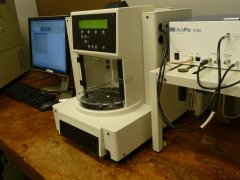Aug 25 2009
Paraytec Ltd. has announced a new application note that demonstrates how its ActiPix HT Nano-Sizing System has been used to rapidly determine the hydrodynamic radius of a series of quantum dot and nanoparticle samples.

Quantum dots are a new form of semiconductors that model atoms. Being only nanometers in size and offering high quantum efficiency, quantum dots are opening up exciting new applications in medical imaging, electronics and optical technologies. Determining the hydrodynamic radius of synthesized samples is of considerable importance as size has a significant effect on the more subtle effects offered by quantum dots.
Applications data presented on the Paraytec website (http://www.paraytec.com/downloads/application-notes/) shows how researchers were able to achieve excellent correlation between experimental and expected values of quantum dot hydrodynamic radii with typical analysis times of less than 10 minutes. Professor Stephen Evans of the Department of Physics at the University of Leeds (UK) commented "We are delighted at the data generated from this study. This approach promises to offer significant benefit to the quantum dot and nanoparticle manufacturing community as it has the potential to enable rapid, on-line size determination in a fraction of the time offered by current methods such as Transmission Electron Microscopy (TEM) ".
The study was performed on the ActiPix HT Nano-Sizing System. This system is a high precision nano-sizing system consisting of a precision nano-injector, autosampler and detector. Samples are typically stored in the autosampler prior to injection of a few nanolitres of each sample into a fused capillary. A plug of the sample, typically 20-100 nL, was injected at the capillary inlet of a specially designed sizing cartridge and driven by application of external pressure along the capillary. UV absorption of the sample was recorded in the first and the second detection window using the ActiPix D100 detector. Whilst the area of each peak is the same, the widths of the peaks are different: the signal from the second window has a greater width and lower amplitude due to Taylor dispersion. The peaks were analysed with an appropriate peak fitting function using software supplied with the system. The area under the peak corresponds to the amount of the quantum dot injected. The standard deviations are used to calculate the hydrodynamic radius of the sample.
Paraytec's multi-award winning product, the ActiPix D100, is the world's first quantitative UV area imaging system. As well as providing superior performance over conventional particle measuring techniques, which cannot effectively measure down to sub 20 nanometre sizes, the patented ActiPix opens up intriguing new possibilities never before possible using conventional detectors.
Paraytec Ltd is a scientific instrument company based in York, UK, designing, developing and manufacturing innovative detectors. Paraytec was established in January 2005 as a spin-out from the Chemistry Department at the University of York, UK. Winner of the prestigious PittCon Editors Silver Award and an R&D 100 Award in 2007, the ActiPix D100 has achieved widespread recognition as a novel analytical instrument delivering applications advances.